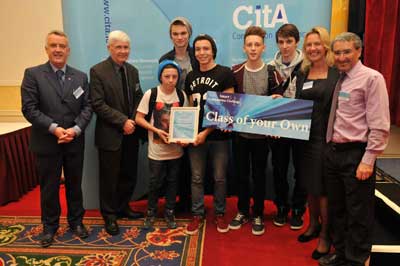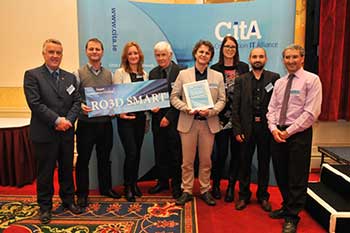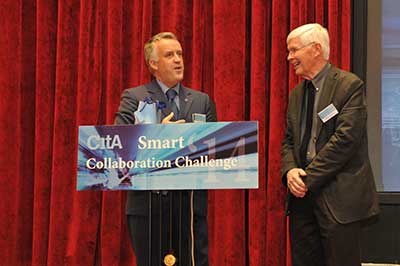A Smart Collaboration
The Construction IT Alliance (CITA) Smart Collaboration Challenge took place between the 10th and the 14th of November 2014 in Dublin. The challenge involved five teams working together to research and explore a solution to a defined challenge in construction using existing and emerging digital technologies.
By Denise Maguire
The teams addressed challenges in areas like property asset management, laser scanning, road construction and the delivery of tangible social outputs through technology. Participants were mostly made up of Irish professionals and students but also included teams from the UK, Slovenia and the US.

One of the highlights of the final day symposium included a standing ovation given to young secondary school students from King Ecgbert School in Sheffield who designed and digitally built a school facility through the help of industry partners and third level students, proving that the next generation of AEC professionals is strongly focusing towards the use of digital tools. Dr Alan Hore, one of the founding directors of CITA who is based in DIT Bolton Street, said: “One of the highlights from the conference was definitely the secondary school team, made up of 15-16 year old children. They demonstrated that there is no fear of technology at that age. Their challenge involved investigating how young teenagers can quite easily adapt to and use technology. In our industry people see technology as a threat so it was great to see such a young group take to it so easily.”
The final day symposium also included presentations from some world respected figures in Building Information Modelling (BIM): Professor Chuck Eastman and Associate Professor Rafael Sacks, authors of the BIM Handbook: A Guide to Building Information Modelling for Owners, Managers, Designers, Engineers and Contractors; Professor Laura Lee of Carnegie Mellon University and Head of BIM Implementation for the UK Cabinet Office Professor David Philp.

After a busy five days of assessment, it was decided that first place should go to RO3D Smart from Slovenia for their innovative research on road reconstruction using 3D point cloud data. Led by Dr Andrej Tibaut and consisting of members of the University of Maribor, the project addressed certain research challenges in the AEC industry:
• Crisis in construction sector is a new opportunity for addressing the prevailing problems in construction: in particular the need to embrace lean concepts, standardization and pre-assembly methods under the umbrella of new BIM technologies.
• Workflow interoperability in construction sector: interoperability between stakeholders in the planning and design phase is efficient, but interoperability in the construction, operations and maintenance phase is inefficient.
• nD modelling of infrastructural objects: although there is still no internationally accepted data model for infrastructure (road and rails) modelling, industrial team partners have recognized BIM as a commercial imperative
• Road reconstruction from a 3D point cloud: It is not straightforward to reconstruct 3D geometric models from 3D point cloud data for road maintenance and reconstruction projects. The team developed technical solutions for BIM modelling of infrastructural objects, including research of emerging BuildingSmart standards (OpenINFRA) related to BIM modelling of infrastructural objects (roads). A roundabout was also surveyed through mobile 3D laser scanning point cloud survey using LIDAR mounted on a car. Software for the detection of road geometry features from 3D point cloud data containing geo-referenced points and obtained from a LIDAR car also came out of the team’s research.
One of the runners up was the Living BIM team, made up of professionals from Accent Property, Topaz, DFM Systems, Arcdox and Portobello Institute. Their project connected BIM to property asset management and facilities management systems to help maintain building information for the full property lifecycle. The team demonstrated how a live, web-based, bi-directional link between BIM and Property/Facilities Management Systems could be used as a platform to collect, structure, collate and manage building information. This would reduce duplication of effort, improve management efficiencies, access and accuracy of information and secure data ownership for property owners.
The Waterford based BIM BUDS team, with participants from Datech Ireland, SIS, Irish Rail, 3rd Dimension and the Waterford Institute of Technology received a Meritorious Award. The team fully explored the impact BIM can have on the retrofitting of Waterford train station through the adoption of various digital technologies. The team demonstrated the idea that a BIM methodology can surpass the boundaries of the tangible outputs in the AECFM sector and into the intangible realm by producing outcomes that have a social consequence to the wider community. The Mercury / DIT team also got a Meritorious Award for their project which used BIM methodologies to reduce re-work by increasing the accuracy needed for point-to-point detailing and clash detection and thus mitigating the risk for off-site prefabrication.
The Class of your Own team, made up of students from King Ecgbert School, were awarded a Meritorious Award. The students learned the importance of cross discipline collaboration to achieve a final design of a community centre in an efficient and professional way. They produced a digital design to a RIBA stage D where it could be presented in detail to convey what the final building will look like in its real world surroundings to stakeholders and importantly, the local community that will use it when built.
The CITA Smart Collaboration Challenge is just one in a number of events organised by CITA, whose aim is to harness the potential of information and communication technologies for the Irish construction sector. CITA works to actively encourage the Irish construction sector to take full advantage of current and emerging Information and communications technologies. Dr Hore was asked, is it working? “In 2012 and 2013, we might have had a bit more interest because the notoriety of the whole BIM thing was fresher. We’re really only seeing the industry recover now so the interest is starting to creep back up. Contractors are quick to recognise the advantages of adopting BIM, they can really leverage the benefits of it. We can now see clients like the HSE mandating BIM on some of their projects, it’s only a matter of time before the penny drops for the rest of the industry. The HSE is using it, the OPW has invested in software and the Department of Education and Skills are looking to BIM on a number of their projects.”
In October 2008, CITA was successful in securing a three year funding contract with Enterprise Ireland for the formation of a Enterprise Innovation Network (EIN) for the Irish construction sector. The EIN initiative was successful in promoting information technology and research and innovation in SME’s. In particular, the project helped SME construction companies develop and utilise technologies that enabled them become more efficient and win international projects. The project also drove implementation in the use of electronic business by SMEs by developing a strong and proactive Network. “Funding from Enterprise Ireland has finished but this has left a strong legacy in the form of the Network. For 2015, CITA has been successful with its Skillnet tender for 2015 so training will go ahead. Focusing on ICT training needs within the industry, Skillnet training targets architects, clients, engineers, main contractors, professional institutions, quantity surveyors, sub-contractors and suppliers. CITA Skillnet is funded by member companies and the Training Networks Programme, an initiative of Skillnets Ltd. funded from the National Training Fund through the Department of Education and Skills.” Training grants received by CITA Skillnet enable the network to provide a discount of up to 30% on most ICT Training courses while training for the unemployed is also provided. 2015 will include events that will focus on how companies can better prepare for Level 2 BIM, which is to be mandated on all public sector projects from mid 2016 and which will likely filter into Ireland soon after. “The CITA BIM Gathering will also return in November 2015 which will hopefully repeat the CITA Collaboration Challenge. We are currently at a detailed point of planning these events.”
In 2015 and beyond, CITA will continue to inform the Irish construction sector of relevant IT developments and encourage IT-related research and training collaboration between the Irish academic sector and the leading firms in the Irish construction sector. Alan and the team are dedicated to encouraging the strategic use of IT by all firms in the Irish construction sector. For full details on how to join CITA, contact www.cita.ie
References:
The BIM Handbook. A Guide to Building Information Modeling for Owners, Managers, Designers, Engineers and Contractors, 2nd Edition. ISBN: 978-0-470-54137-1 (July 2011)

